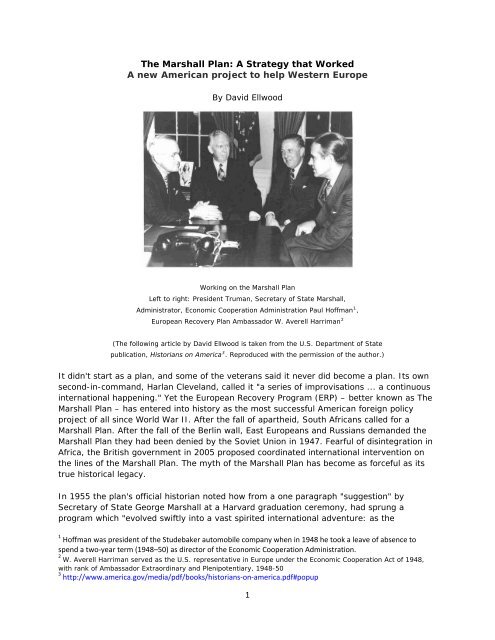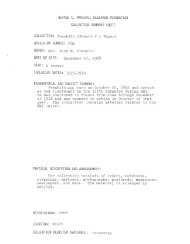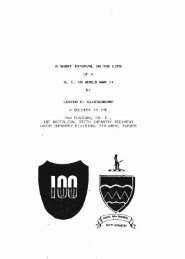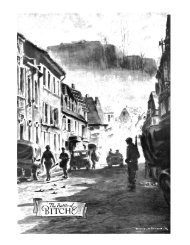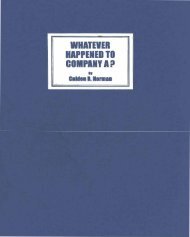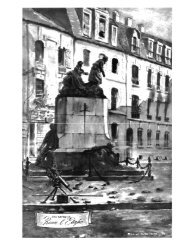The Marshall Plan: A Strategy that Worked A new American project ...
The Marshall Plan: A Strategy that Worked A new American project ...
The Marshall Plan: A Strategy that Worked A new American project ...
Create successful ePaper yourself
Turn your PDF publications into a flip-book with our unique Google optimized e-Paper software.
<strong>The</strong> <strong>Marshall</strong> <strong>Plan</strong>: A <strong>Strategy</strong> <strong>that</strong> <strong>Worked</strong><br />
A <strong>new</strong> <strong>American</strong> <strong>project</strong> to help Western Europe<br />
By David Ellwood<br />
Working on the <strong>Marshall</strong> <strong>Plan</strong><br />
Left to right: President Truman, Secretary of State <strong>Marshall</strong>,<br />
Administrator, Economic Cooperation Administration Paul Hoffman 1 ,<br />
European Recovery <strong>Plan</strong> Ambassador W. Averell Harriman 2<br />
(<strong>The</strong> following article by David Ellwood is taken from the U.S. Department of State<br />
publication, Historians on America 3 . Reproduced with the permission of the author.)<br />
It didn't start as a plan, and some of the veterans said it never did become a plan. Its own<br />
second-in-command, Harlan Cleveland, called it "a series of improvisations ... a continuous<br />
international happening." Yet the European Recovery Program (ERP) – better known as <strong>The</strong><br />
<strong>Marshall</strong> <strong>Plan</strong> – has entered into history as the most successful <strong>American</strong> foreign policy<br />
<strong>project</strong> of all since World War II. After the fall of apartheid, South Africans called for a<br />
<strong>Marshall</strong> <strong>Plan</strong>. After the fall of the Berlin wall, East Europeans and Russians demanded the<br />
<strong>Marshall</strong> <strong>Plan</strong> they had been denied by the Soviet Union in 1947. Fearful of disintegration in<br />
Africa, the British government in 2005 proposed coordinated international intervention on<br />
the lines of the <strong>Marshall</strong> <strong>Plan</strong>. <strong>The</strong> myth of the <strong>Marshall</strong> <strong>Plan</strong> has become as forceful as its<br />
true historical legacy.<br />
In 1955 the plan's official historian noted how from a one paragraph "suggestion" by<br />
Secretary of State George <strong>Marshall</strong> at a Harvard graduation ceremony, had sprung a<br />
program which "evolved swiftly into a vast spirited international adventure: as the<br />
1 Hoffman was president of the Studebaker automobile company when in 1948 he took a leave of absence to<br />
spend a two‐year term (1948–50) as director of the Economic Cooperation Administration.<br />
2 W. Averell Harriman served as the U.S. representative in Europe under the Economic Cooperation Act of 1948,<br />
with rank of Ambassador Extraordinary and Plenipotentiary, 1948-50<br />
3 http://www.america.gov/media/pdf/books/historians‐on‐america.pdf#popup<br />
1
enterprise unfolded it became many things to many men." Fifty years later, such was the<br />
fame of the <strong>project</strong>, <strong>that</strong> the same could still be said.<br />
<strong>The</strong> Inception of an Idea<br />
Three contingent developments led to the creation of a special <strong>new</strong> <strong>American</strong> <strong>project</strong> to help<br />
Western Europe in the spring of 1947. <strong>The</strong> first was the physical condition of the post-World<br />
War II continent after the setbacks caused by the extreme winter of 1946-47. Second was<br />
the failure of the recent Truman Doctrine – an outspoken scheme to help Greece and Turkey<br />
fight Soviet pressures – to indicate a constructive way forward for all. Third was the<br />
grueling experience of Secretary of State George <strong>Marshall</strong> in the Moscow Conference of<br />
Foreign Ministers, dedicated to the future of Germany, in March-April 1947.<br />
<strong>Marshall</strong> had been recalled to become secretary of state by President Harry S Truman at the<br />
beginning of 1947, after retiring from the Pentagon at the end of the war as Army chief of<br />
staff. <strong>Marshall</strong>'s success in <strong>that</strong> job – Churchill called him "the organizer of victory" – and<br />
his personal qualities of incisiveness, integrity, and self-abnegation made him one of the<br />
most authoritative public figures of the era. His patience and sense of duty were tested to<br />
the full in Moscow. A senior <strong>American</strong> diplomat, George Kennan, summarized <strong>Marshall</strong>'s<br />
pithy conclusion upon leaving the Soviet capital:<br />
Europe was in a mess. Something would have to be done. If he (<strong>Marshall</strong>) did<br />
not take the initiative, others would.<br />
Kennan and his <strong>new</strong> State Department "Policy <strong>Plan</strong>ning Staff" produced one of the masterdocuments<br />
from which the <strong>Marshall</strong> <strong>Plan</strong> eventually flowed. In part, their thinking derived<br />
from Roosevelt-era understandings of the causes of two world wars and the Great<br />
Depression: class hate, poverty, backwardness, and the lack of hope for change. It was a<br />
key intention of the people in Washington rebuilding the world after the war to support the<br />
ordinary citizen's demand for a share in the benefits of industrialism. People with prosperity,<br />
or at least the prospect of it, didn't turn to totalitarianism, they believed.<br />
But there was a specific European dimension to the <strong>Marshall</strong> effort, which came from the<br />
same reflections. Europe's evil genie, said people like Kennan, Assistant Secretary of State<br />
Dean Acheson, and future ERP Ambassador Averell Harriman, was nationalism. If <strong>that</strong> root<br />
of Nazi-fascism and all the rivalries of the 1930s could be bottled up in an integrated<br />
economic framework, uniting all the Old World, then prosperity might stand a chance, and<br />
Europe's urge to start world wars and then drag America into them might finally be killed<br />
off.<br />
In these ways, modernization and integration became the twin watchwords of the ERP, and<br />
the arguments turned round how to bring them about. It was central to the method of the<br />
<strong>Marshall</strong> <strong>Plan</strong> <strong>that</strong> the Europeans should think and act for themselves within the vision: That<br />
was what made the plan not just another aid program.<br />
In <strong>Marshall</strong>'s brief and outwardly simple comments at Harvard, in June 1947, there were,<br />
first of all, explanations of Europe's devastation and hopelessness. <strong>The</strong>re were warnings for<br />
2
those who sought to exploit the misery politically. <strong>The</strong>re was a clear signal <strong>that</strong> ideology (at<br />
<strong>that</strong> point in history, Communism) should not count in reconstruction. <strong>The</strong>n came the crux<br />
of the speech, a tantalizing paragraph inviting the Europeans to agree together on what<br />
they needed and what they might do were the United States to step in. <strong>The</strong> U.S. role,<br />
<strong>Marshall</strong> said, "should consist of friendly aid in the drafting of a European program and of<br />
later support of such a program so far as it may be practical for us to do so." <strong>The</strong> secretary<br />
of state insisted <strong>that</strong> the Europeans must act jointly, and <strong>that</strong> "a cure and not a palliative"<br />
must be sought. He concluded by urging his fellow <strong>American</strong>s to "face up to the vast<br />
responsibility which history has clearly placed upon our country."<br />
"We expected them to jump two inches and they've jumped six feet," wrote one <strong>American</strong><br />
journalist. In less than two weeks, the French and British foreign ministers set in motion in<br />
Paris a Conference on European Economic Cooperation (CEEC), which, in stages between<br />
the end of June and the end of September, with the help of 14 other governments, prepared<br />
a report to the State Department on the total economic aid they thought they needed. Most<br />
of those represented did not have a national plan and some not even an overall picture of<br />
their nation's economy. With no experience of any sort in joint, continent-wide planning, the<br />
delegates arrived at a grand total of $28 billion. <strong>The</strong> figure was rejected immediately by<br />
Washington as hopelessly optimistic.<br />
But the Paris CEEC event was most famous for the arrival – and swift departure – of a large<br />
Soviet delegation headed by the Kremlin's foreign minister, Vyacheslav Molotov. In this stillcontroversial<br />
crisis of Cold War history, the Russians were confronted with the Western<br />
proposal for a jointly formulated and implemented recovery strategy treating the whole of<br />
Europe, including Germany, as a single economic entity. As anticipated in Washington, they<br />
walked out, insisting <strong>that</strong> the <strong>American</strong>s and their key allies had no other intention than to<br />
line up Europe's economies under their own control and launch a <strong>new</strong> world division of<br />
labor: great power imperialism in its latest, <strong>American</strong>, guise. Soviet pressure on East<br />
European nations intensified after the rupture among the World War II allies. In February<br />
1948, Czechoslovakia became the victim of a pro-Communist coup d'état instigated by<br />
Moscow.<br />
Setting the <strong>Plan</strong> in Motion<br />
After a long winter of discussion, some stop-gap help, and greatly increased tension in East-<br />
West relations, the European Recovery Program was born officially with an act of Congress<br />
signed by President Truman in April 1948. To administer the <strong>project</strong>, a <strong>new</strong> federal agency,<br />
the Economic Cooperation Administration (ECA), was brought into being at the same time,<br />
headed by the CEO of the Studebaker automobile company, Paul G. Hoffmann, a<br />
Republican, symbolizing bipartisan support for the program. Expenditures began to flow<br />
immediately, under tight Congressional supervision.<br />
<strong>The</strong> program's official enactment identified the supreme objective as creating in Western<br />
Europe "a healthy economy independent of extraordinary outside assistance" by 1952. To<br />
this end, comments the economic historian Imanuel Wexler, " the act stipulated a recovery<br />
plan based on four specific endeavours: (1) a strong production effort, (2) expansion of<br />
foreign trade, (3) the creation and maintenance of internal financial stability, and (4) the<br />
3
development of (European) economic cooperation." To the dismay of many Europeans who<br />
had counted simply on a big relief program, it soon became clear <strong>that</strong> such an agenda could<br />
only be realized by way of permanent structural change in the European economies, singly<br />
and together, as a whole. This was what <strong>Marshall</strong> had meant when he talked of "a cure<br />
rather than a palliative," nothing less.<br />
To meet the challenge, the ongoing Conference on European Economic Cooperation (CEEC)<br />
quickly turned itself into the Organization for European Economic Cooperation (OEEC),<br />
under the Belgian foreign minister, Paul-Henri Spaak. In the meantime, <strong>American</strong> embassies<br />
in each of the member nations were obtaining signatures on the bilateral pacts which<br />
spelled out the obligations of European governments towards their <strong>new</strong> sponsors. Among<br />
them was recognition of the authority of the ECA "Mission" to be set up in each national<br />
capital. A formal committee would link each mission to its participating government, in<br />
order to supervise the running of the program on the ground.<br />
<strong>The</strong> committee's key task was to make plans for spending productively the sums in the <strong>new</strong><br />
"Counterpart Fund." This was a characterizing feature of the whole operation, the tool <strong>that</strong><br />
most distinguished the <strong>Marshall</strong> <strong>Plan</strong> from any conventional aid program. <strong>The</strong> fund was an<br />
account at each national bank specially created to contain the proceeds from the local sale<br />
of ERP-supplied goods. Much of the help, it turned out, would not be as free, or as liquid, as<br />
the Europeans had imagined. It would instead normally be merchandise sent from the<br />
United States and sold to the highest bidder, public or private. <strong>The</strong>ir payments would then<br />
go back not to the United States, but into the <strong>new</strong> fund. From it would come the money to<br />
pay for national reconstruction and modernization efforts, as decided between the ECA<br />
Mission and the government in each participating capital.<br />
At the same time the ERP was clearly a mighty weapon in the Cold War. Its senior<br />
representative in Europe, Ambassador Harriman, went so far in 1949 as to characterize the<br />
entire effort as a "fire-fighting operation." <strong>Marshall</strong>'s successor as secretary of state, Dean<br />
Acheson, the individual who, in his own words, " probably made as many speeches and<br />
answered as many questions about the <strong>Marshall</strong> <strong>Plan</strong> as any man alive," remembered <strong>that</strong><br />
"what citizens and the representatives in Congress always wanted to learn in the last<br />
analysis was how <strong>Marshall</strong> Aid operated to block the extension of Soviet power and the<br />
acceptance of Communist economic and political organization and alignment." Against the<br />
plan indeed stood the forces of the Cominform, an international propaganda organization<br />
set up in October 1947 by the Kremlin with the explicit purpose of combating the <strong>Marshall</strong><br />
<strong>Plan</strong>, internationally and – using local Communist parties – within each participating nation.<br />
At a time when Communist forces were leading armed insurgency in Greece, looked capable<br />
of taking power politically in Italy, seemed to threaten chaos in France, and k<strong>new</strong> what they<br />
wanted in Germany – unlike the West at this stage – the Cold War gave an urgency to the<br />
program which concentrated minds everywhere.<br />
Selling the <strong>Plan</strong> to Its Beneficiaries<br />
From the very beginning the ECA planners had been aware <strong>that</strong> to tackle the political<br />
obstacles their efforts were likely to encounter, they would have to go over the heads of the<br />
local governing classes and speak directly to the people. Improvising swiftly, the teams of<br />
4
journalists and filmmakers who launched the ERP "Information Program" turned it, by the<br />
end of 1949, into the largest propaganda operation directed by one country to a group of<br />
others ever seen in peacetime.<br />
A January 1950 report by Mike Berding, the ERP information director in Rome, instructed:<br />
Carry the message of the <strong>Marshall</strong> <strong>Plan</strong> to the people. Carry it to them directly<br />
– it won't permeate down. And give it to them so <strong>that</strong> they can understand it.<br />
No idea seemed too large or daring for the Information Program in its heyday. Workers,<br />
managers, and employers were told of the benefits of greater production and productivity,<br />
scientific management, and a single-market Europe. In each country there were specialized<br />
publications on these subjects, joint committees, trips by European leaders to inspect<br />
<strong>American</strong> factories, conferences and eventually, in some places, even "productivity villages"<br />
where model factories and workers' communities could be seen in action. For other groups<br />
in society – state employees, teachers, families, even schoolchildren – the promises of the<br />
<strong>American</strong> information campaign were more jobs, higher living standards, and ultimately<br />
peace in a Europe without rivalries. <strong>The</strong> Information Program eventually produced tens of<br />
documentary films, hundreds of radio programs, thousands of copies of its pamphlets, and<br />
attracted millions of spectators for its mobile exhibitions.<br />
Here posters, models, illuminated displays, audio messages, and films would present the<br />
plan as graphically as possible, for every level of understanding. A booklet from a display at<br />
the Venice exhibit of summer 1949 opens with a dramatic quantification of the aid arriving<br />
at <strong>that</strong> time: three ships a day, $1,000 a minute, two weeks' salary from every <strong>American</strong><br />
worker. <strong>The</strong> goals and the methods of the program are explained in everyday language,<br />
with the details explaining how work has been restored to lifeless industries, how <strong>new</strong><br />
machinery has modernized factories and how greater output is needed Europe-wide to<br />
stabilize economic life on a continental scale. <strong>The</strong> concluding message states <strong>that</strong>:<br />
ERP is a unique chance offered to European nations towards reconstructing<br />
their economies, raising the standard of living among the masses, and<br />
attaining by the year 1952 an economic stability which is the foundation of<br />
political independence. ... Every worker, every citizen is bound up in this<br />
rebirth. <strong>The</strong> future and the peace of Italy and of Europe, the general well<br />
being of all, depend on the will and the work of each single one of us.<br />
<strong>The</strong> <strong>Plan</strong> Evolves<br />
<strong>The</strong> plan's early years, from June 1948 to the start of the Korean war in June 1950, were<br />
remembered by all concerned as the golden epoch of pure economic action and rewards.<br />
Experts pointed to the rise of nearly a quarter in the total output of goods and services <strong>that</strong><br />
the ERP countries enjoyed between 1947 and 1949. <strong>The</strong>y asserted <strong>that</strong> the "over-all index<br />
of production, based on 1938, rose to 115 in 1949, as compared with 77 in 1946 and 87 in<br />
1947." Agriculture, too, recovered, and progress on the inflation front was considered<br />
"uneven but definitely encouraging." <strong>The</strong> foreign trade of the member states was back to its<br />
prewar levels, but its most remarkable feature was a change in direction. No longer oriented<br />
5
towards the old European empires, trade was increasing most rapidly within Western<br />
Europe, among the ERP members themselves. Experience would show <strong>that</strong> this was a longterm<br />
structural shift in the continent's economy, which within a few years would set going<br />
political demands for European integration.<br />
Meanwhile, by the end of 1949 it had become clear <strong>that</strong> the partner nations had visions of<br />
the European Recovery Program <strong>that</strong> differed in significant respects from those of the<br />
<strong>American</strong> planners when the hard choices came to be made. Across Western Europe,<br />
governments badly needed the ERP dollars, but at the same time they sought to make their<br />
own deal with what the <strong>American</strong>s were offering and, especially, with what they were<br />
demanding in exchange. If dependence on the United States there was to be for a while,<br />
then it should in any case be conditional, on "our" terms, the Europeans felt.<br />
<strong>The</strong> British went to extraordinary lengths to resist the <strong>Marshall</strong> <strong>Plan</strong>'s insistence on<br />
immediate economic integration with the rest of Europe, the great string attached to<br />
<strong>Marshall</strong> aid everywhere. <strong>The</strong> Dutch resisted pressure to start dismantling their empire in<br />
the name of free trade. <strong>The</strong> Austrians refused point blank to reform their railways and their<br />
banking system as the <strong>American</strong>s desired. <strong>The</strong> Greek people rejected a <strong>new</strong> ERP-sponsored<br />
currency because they believed <strong>that</strong> gold sovereigns were the only truly reliable form of<br />
monetary exchange. <strong>The</strong> head of the Italian industrialists told the mission chief in Rome<br />
<strong>that</strong> no matter how cheap synthetic fibers became, Italian women would always prefer<br />
clothes made in the home with natural materials. Tinned food might be sold very cheaply,<br />
he said, but Italian traditions of cooking would always be preferred. Small firms and<br />
traditional artisan skills would be central to Italy's future, just as they had been in the past.<br />
By the start of 1950, practical experience and extensive opinion polling had brought a<br />
significant shift in outlook, to the point where the strategists felt obliged to concede <strong>that</strong><br />
"the majority of Europeans today" had one overriding concern of their own: security.<br />
Gradually, in spite of America's reliance on a liberal capitalist economy, the <strong>Marshall</strong><br />
planners were obliged to recognize the depth of the European commitment to the idea of<br />
the non-Communist social welfare state. <strong>The</strong>y insisted simply <strong>that</strong> its benefits be distributed<br />
as widely as possible, to cut the ground from under Communist attacks, both on the plan<br />
and on reformist social democratic ideals.<br />
<strong>The</strong> Impact of Korea<br />
But the unexpected and fear-inspiring turn of events in Asia in 1950 soon put the very<br />
existence of the <strong>Marshall</strong> <strong>Plan</strong> in doubt. <strong>The</strong> sharply intensified Cold War confrontation <strong>that</strong><br />
started with the North Korean invasion of the South in June shortened the <strong>project</strong> in time<br />
and radically transformed it, opening the way to the era of general rearmament and "Mutual<br />
Security." Congressional amendments of 1951 and 1952 to the original ERP Act provided<br />
$400 million more for a continuing drive to persuade European employers and workers to<br />
"accept the <strong>American</strong> definition of the social and economic desirabilities [sic] of<br />
productivity," but now so <strong>that</strong> military output for national defense against the Soviet threat<br />
could be increased at the same time as consumer goods. Everyone was expected to do<br />
more for the general effort (hence strengthening NATO), and so rebuild their armed forces,<br />
greatly run down since the end of WWII. <strong>The</strong> ECA men on the ground quickly decided <strong>that</strong><br />
6
there was no conflict between America's demand for general rearmament and the traditional<br />
ERP objectives: It was just a matter of bending the existing policy goals to the <strong>new</strong><br />
requirements.<br />
In such a context the successful ERP Information Program soon accelerated into something<br />
resembling "psychological warfare," with the world of industry and organized labor identified<br />
as the key front in the ideological Cold War against Communism. As one of the ERP's most<br />
influential brains, Assistant Administrator (and later Acting Administrator) Richard M. Bissell,<br />
explained in Foreign Affairs in April 1951, the United States could wage this war in Europe<br />
most effectively by the force of its economic example and the powerful appeal of its<br />
consumerist economy to Europeans of all regions and social classes:<br />
Coca-Cola and Hollywood movies may be regarded as two products of a<br />
shallow and crude civilization. But <strong>American</strong> machinery, <strong>American</strong> labor<br />
relations, and <strong>American</strong> management and engineering are everywhere<br />
respected. ... What is needed is a peaceful revolution which can incorporate<br />
into the European economic system certain established and attractive<br />
features of our own, ranging from high volumes to collective bargaining. ...<br />
[This] will require a profound shift in social attitudes, attuning them to the<br />
mid-twentieth century.<br />
<strong>The</strong> Balance Sheet<br />
In the end, every participating nation succeeded in carrying out its own distinctive version<br />
of Richard Bissell's peaceful revolution. Economically, the <strong>Marshall</strong> <strong>Plan</strong> mattered far more in<br />
Greece, France, Austria, and Holland than it did in Ireland, Norway, or Belgium. For some<br />
nations, such as Italy, it was perhaps truly decisive for one year only, for others, the<br />
benefits flowed for several years. Each nation made different use of the economic impetus<br />
provided by the plan. <strong>The</strong> Danes secured raw materials and energy supplies. Other peoples,<br />
such as those in the German occupation zones, appreciated most the food provided by the<br />
ERP. In Italy and Greece, help with rebuilding railways, roads, and power supplies gave the<br />
most lasting benefit. In France, industrial investment came first; in Britain, the Counterpart<br />
Fund was almost entirely used to pay wartime debts and re-float sterling.<br />
Both Austria and Sweden, each in its own way, believe <strong>that</strong> their successful anchorage in<br />
the West dates back to the <strong>Marshall</strong> <strong>Plan</strong>. If Communist parties grew in Italy and France,<br />
they at least did not take control, and these nations remained oriented towards the West.<br />
Perhaps Germany was the nation <strong>that</strong> benefited most overall, as the dynamic of European<br />
integration conceived and fostered by the ERP allowed the <strong>new</strong> Federal Republic to grow in<br />
strength and respectability while calming the suspicions of its neighbors. <strong>The</strong> hoped-for<br />
revolution in Franco-German relations did indeed come about. Whatever its other origins in<br />
short-term, Cold War necessities, no political development heightened the contrast with the<br />
post-World War I era more than this one.<br />
Fifty years after the great experience, Jim Warren, a <strong>Marshall</strong> planner in Greece, rejoiced:<br />
7
We had a goal; we had fire in our bellies; we worked like hell; we had tough,<br />
disciplined thinking, and we could program, strive for, and see results.<br />
For a short, intense period, a <strong>new</strong> <strong>American</strong> presence arrived in Europe, dedicated to finding<br />
ways to translate the successes of the <strong>American</strong> economic experience into recipes for the<br />
political salvation of others, and so turn <strong>American</strong> myth into model. Appreciative Europeans<br />
of the time spoke of "a sense of hope and confidence" these <strong>American</strong> planners brought – of<br />
"restored courage and reawakened energy" in the Old World.<br />
In Europe the clash of imported and native models provided the energy to set the great<br />
1950s boom going. <strong>The</strong> European Recovery Program had supplied the spark to set the chain<br />
reaction in motion. In 1957 came the Treaty of Rome, which launched the European<br />
Economic Community. Although this scheme of fledgling economic integration was far less<br />
radical than the <strong>American</strong> visionaries of 1949 had demanded, of the inheritance left by the<br />
<strong>Marshall</strong> <strong>Plan</strong> and its promises, none was more concrete. This founding document initiated<br />
Europe's peaceful economic integration, a process <strong>that</strong> continues to this day.<br />
As for the <strong>American</strong>s, following a wobbly emergence in World War I as an international<br />
power, they had finally developed foreign policies and a grand strategy "consonant with our<br />
<strong>new</strong> responsibilities as the greatest creditor, greatest producer, and greatest consumer of<br />
the 20th century" – as Vera Micheles Dean put it in 1950 in a book entitled Europe and the<br />
United States. <strong>The</strong>y had also endowed themselves with a <strong>new</strong> national image of America as<br />
a power <strong>that</strong> could successfully blend military, political, and economic leadership on an<br />
international scale, an image destined to reappear whenever nations turned from war and<br />
misery to reach forward towards a <strong>new</strong>, more hopeful future.<br />
David Ellwood is an associate professor in international history, University of Bologna, and an adjunct professor<br />
with Johns Hopkins University's School of Advanced International Studies (SAIS), Bologna Center. His publications<br />
on postwar European history include: Italy 1943-1945: <strong>The</strong> Politics of Liberation and Rebuilding Europe: Western<br />
Europe, America and Postwar Reconstruction. His current <strong>project</strong> is America and the Politics of Modernization in<br />
Europe, to be published by Oxford University Press. Professor Ellwood is a 2006 fellow of the Rothermere America<br />
Institute at Oxford University.<br />
8


